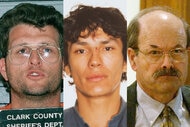Create a free profile to get unlimited access to exclusive videos, breaking news, sweepstakes, and more!
The Not So Sweet Tale Of The ‘Candy Man’ Killer And His Teen Accomplice, As Seen On 'Mindhunter'
The true story of pedophilic Houston-area killer Dean "Candy Man" Corll and his young accomplice, Elmer Henley, is arguably more horrifying than anything in film or urban legend.

The cryptic nickname "Candy Man" conjures up all kinds of creepy depictions of candy-coated predators. There’s the 1992 slasher film “Candyman,” which dramatizes an urban legend about a slave owner’s son who is seeking out revenge. Then, there’s the real life horror story from the 1970s of a Texan who poisoned neighborhood kids, including two of his own, with Pixie Sticks on Halloween. One of the children died — the killer’s son — and the killer was executed a decade later. Of course there’s also "The Candy Man" song from the arguably creepy “Willy Wonka & the Chocolate Factory.”
But have you heard of “Candy Man” Dean Corll, arguably the most deviant “Candy Man” who ever existed, real or fictional? He was actually believed to be the most prolific serial killer of his time, surpassing the infamous Boston Strangler.
Netflix's “Mindhunter” is a fictionalized account of real-life FBI profiler John Douglas’ endeavors interviewing and investigating real life killers, mostly of the serial variety.
The second season focused primarily on the Atlanta Child Murders, but it also incorporated several storylines involving other real-life killers, including a prison interview with one of Corll’s victims, who ended up becoming his accomplice. That man, Elmer Wayne Henley, Jr., ultimately ended up murdering Corll when he was just a teen.
Before interviewing Henley, the FBI team discussed Henley and Corll’s crimes. They noted that Corll was known around Houston as the “Candy Man” — he gave free candy (or drugs) to teenage boys to lure them into being kidnapped, raped, tortured and often killed. In all, he killed 28 victims. Henley was 14 when he met Corll. He could have been one of his many murder victims, but instead assisted in some of the murders.
In the show, Henley’s character maintains that he yes, he helped lure other teens to Corll.
“He told me he was looking for white, good-looking and young,” Henley’s character recalled.
When asked what if it was like to kill Corll, if it was difficult to do so, his character replied, “Nah, it was cool.”
He claimed he only killed Corll, not anyone else, despite being convicted of killing six.
The real-life Henley received six life sentences in 1974 for killing Corll and for helping him in killing others, and he’s still incarcerated in Tennessee.
As for the real-life Corll, he’s obviously dead, after Henley killed him at age 17. That murder halted Corll’s horrific murder spree.
The nickname “Candy Man” isn’t just about the free candy and drugs he offered to children to lure them into abuse. His family also owned a candy factory, according to Houstonia. He became vice president of his family’s “Corll Candy Company” after being discharged from the army, according to the 1974 book “The Man with the Candy: The Story of the Houston Mass Murders.” His profession allowed him to give out free candy to kids in the Houston Heights, where he lived. He also became known as the “Pied Piper,” referencing a legend from the Middle Ages about a man who lured over 100 children out of a town to avenge its mayor, who neglected to pay him what he was owed.
Corll is no legend, and he did indeed kill 28 people between 1970 and 1973 — along with the help of Henley and another teen accomplice, David Owen Brooks. The victims were males aged 13 to 20, and most of them were in their mid-teens.
Brooks met Corll when Brooks was in the sixth grade and soon Corll was sexually abusing him, according to an archived article. Brooks is currently also serving time for his role in the murders.
The murder victims were also sexually assaulted before being strangled or shot to death. Then, their bodies were tied in plastic sheeting. Many of the bodies were discovered in an isolated section of a beach, according to an archived Associated Press report. Others were found in a wooded area. Corll was known for keeping trophies of his victims, namely keys, according to the Houston Ledger.
His reign of terror was cut short when at 33, he was shot to death in his Pasadena home, a Houston suburb, by Henley, according to a 2011 Texas Monthly article which detailed how the horrors affected the area.
News of the murders shocked the country, as the death toll surpassed all serial killings at the time (serial killer was not yet an actual term). Reporters flocked to the area, including author Truman Capote, according to the Texas Monthly.
The report went on to note that, although two books were quickly published about the shocking case at the time, for some reason the case went on to become largely forgotten by media.
All in all, there is absolutely nothing sweet about this real life tale.

























